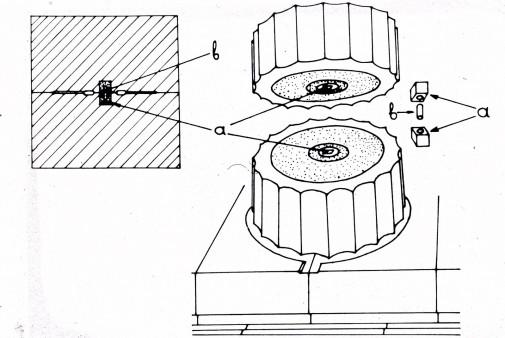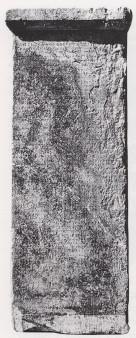George Varoufakis / University of Athens
http://www.archaiologia.gr/en/blog/2014/06/23/the-inscribed-stele-of-eleusis-and-quality-control-in-antiquity/

Fig. 1. The 4th c. BC. inscription from Eleusis. Inscribed on it is one of the most ancient European standard models as well as specifications for the composition of bronze dowels placed between the drums of the columns of the Portico of Philo (the Archaeological Museum of Eleusis).
In 1863, D. Filios discovered an inscribed stele of the 4th century BC (fig. 1) in Eleusis. The study of its text by the author led to a very interesting conclusion; this inscription is the most ancient example of its kind with strict specifications for the manufacture of bronze fittings known as empolia and poloi, that is, the bronze dowels used to join the drums of the columns of the Portico of Philo, a beautiful building that was to be erected in front of an earlier temple, the well known Telesterion of Eleusis (fig. 2.).

Fig. 2. The Portico of Philo, a beautiful building of the 4th c. BC, erected in front of the earlier Telesterion of Eleusis (model by Ioannis Travlos. Archaeological Museum of Eleusis).
The specifications concerned the chemical composition and the manufacturing of the bronze fittings (fig. 3) but especially that of the poloi.

Fig. 3. Copy of poloi (b) and empolia (a) between two drums of a column.
At some point, the inscription mentions the following interesting fact: «Τους δε πόλους τορνεύση κατά το παράδειγμα…». Meaning “to shape hard bronze on the lathe into cylindrical dowels (b) according to a particular sample…”
Most important, however, is the reference to the origin of the raw material and its composition: «χαλκού δε εργάσεται Μαριέως, κεκραμένου την δωδεκάτην, τα ένδεκα μέρη χαλκού, το δε δωδέκατον καττιτέρου».
This would mean in free translation: ”the copper must be produced in Marius, Cyprus (a large commercial and metallurgical centre in antiquity) and of its twelve parts, eleven were to be of copper and one of tin”. That is, approximately 8,33% to 8,50% in our system.
At this point it should be mentioned that when the ancient Greeks referred to copper they meant both that particular metal but also krateroma (commonly known as brass or bronze) which is an alloy of copper and tin. The same applies to iron. They meant soft iron but also hard steel, that is an alloy of iron and carbon (in the form of cementite, Fe3C).

Fig. 4. Inscribed stele from the Stoa of Attalos. It refers to the Athenian law of 375 BC about quality control of Attic silver coinage.
Study of the inscription’s text lead to the astounding conclusion that the ancient Greeks applied standards with strict requirements in each case. This means that there was also a definite quality control. Otherwise the text’s specifications (and other specifications as well) would have been of no value and there would have been great danger of fraud.
At this point it would be worth mentioning that the price of copper was 35 drachmas per talent, while that of tin was 230 drachmas, in other words, approximately seven times higher. The author confirmed that the combined weight of the columns of the Portico of Philo exceeded 3 tons (3,300 t), based on the following data given accurately by the inscription: the number of the actual columns, the number of their drums, the dimensions of the empolia and poloi. The content in tin may have been 8,33%, but the actual mass of this metal when used would in fact represent 37% of the alloy’s total value, since as was stated, its price was 7 times greater than that of copper.
PART.2